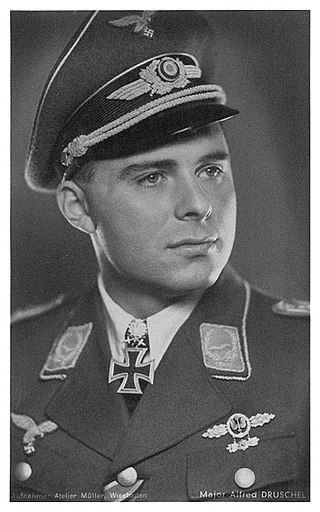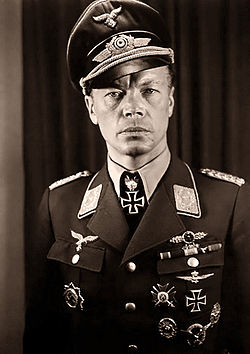
Alfred Druschel was a German Luftwaffe combat pilot during World War II. He was a recipient of the Knight's Cross of the Iron Cross with Oak Leaves and Swords of Nazi Germany.

Ernst Kupfer was a ground-attack pilot in the Luftwaffe of Nazi Germany during World War II who commanded a wing of Stuka aircraft. He was a recipient of the Knight's Cross of the Iron Cross with Oak Leaves and Swords.

Ernst Gadermann was a German physician in the Wehrmacht of Nazi Germany during World War II. He was a recipient of the Knight's Cross of the Iron Cross. After World War II he became a well known cardiologist.

August Lambert was a German Luftwaffe military aviator and ground-attack pilot during World War II. As a fighter ace, he is credited with 116 aerial victories claimed in approximately 350 combat missions for which he was awarded the Knight's Cross of the Iron Cross, the highest award in the military and paramilitary forces of Nazi Germany during World War II. All of his aerial victories were claimed on the Eastern Front as a ground attack pilot in a Schlachtgeschwader, not as a fighter pilot in a Jagdgeschwader. He is the highest scoring ground attack pilot.
Kurt Kuhlmey was a general in the West German Air Force. During World War II, he served as ground-attack aircraft pilot in the Luftwaffe, commanding two air wings. Kuhlmey flew over 500 combat missions, and in July 1942 was awarded the Knight's Cross of the Iron Cross.

Hans-Karl Stepp was a German ground attack pilot and wing commander during World War II. He was a recipient of the Knight's Cross of the Iron Cross with Oak Leaves, a grade of the highest award in the military and paramilitary forces of Nazi Germany during World War II.
Hermann Lukas Plocher was a German general during World War II. He was a recipient of the Knight's Cross of the Iron Cross with Oak Leaves of Nazi Germany.
Wolfgang Pickert was a general in the Luftwaffe of Nazi Germany during World War II who commanded the III Flak Corps. He was a recipient of the Knight's Cross of the Iron Cross with Oak Leaves.
Johann Ludwig Müller was a German general in the Wehrmacht during World War II, and a recipient of the Knight's Cross of the Iron Cross with Oak Leaves of Nazi Germany.
Gerhard Heinrich Lindemann was a German general (Generalmajor) in the Wehrmacht during World War II, and a recipient of the Knight's Cross of the Iron Cross with Oak Leaves, awarded by Nazi Germany for successful military leadership.

Georg Dörffel was a highly decorated Oberstleutnant in the Luftwaffe during World War II, and one of only 882 recipients of the Knight's Cross of the Iron Cross with Oak Leaves. Georg Dörffel was killed on 26 May 1944, north of Rome. During his career he flew 1004 missions as a ground assault pilot. He was posthumously promoted to Oberstleutnant.
Hans-Henning Freiherr von Beust was an officer in the Luftwaffe of Nazi Germany during World War II who commanded the 27th Bomber Wing. He was a recipient of the Knight's Cross of the Iron Cross with Oak Leaves. Beust joined the Bundeswehr in 1957 and retired in 1971.
Walter Sigel was a German air officer during World War II. He was a recipient of the Knight's Cross of the Iron Cross with Oak Leaves of Nazi Germany. He led the German bombers during the bombing of Wieluń, the first aerial bombing of the war. Sigel died on 8 May 1944 after crashing his aircraft into Trondheim Fjord.
Helmut Bruck was a German pilot during World War II. He was a recipient of the Knight's Cross of the Iron Cross with Oak Leaves of Nazi Germany. During his career he flew 973 missions.
Wilhelm Meyn was a general in the German Air Force. During World War II, he served in the Luftwaffe and was a recipient of the Knight's Cross of the Iron Cross of Nazi Germany. In 1956, he joined the Bundeswehr of West Germany and rose to the rank of Generalmajor, retiring in 1979.
Paul Freiherr von Hauser was an officer in the Wehrmacht during World War II who commanded the Panzer Lehr Division. He was a recipient of the Knight's Cross of the Iron Cross with Oak Leaves of Nazi Germany. Oberst (colonel) Hauser surrendered the division to the American forces in the Ruhr Pocket on April 15, 1945.
Frank Neubert was a highly decorated Major in the Luftwaffe during World War II, and a recipient of the Knight's Cross of the Iron Cross. He is believed to have been the first victor in aerial combat in World War II after shooting down Captain Mieczyslaw Medwecki's PZL P.11 in the early hours of 1 September 1939. The Knight's Cross of the Iron Cross was awarded to recognise extreme battlefield bravery or successful military leadership. During his career he was credited with participating in 350+ missions.

Joachim von Siegroth was a general in the Wehrmacht of Nazi Germany during World War II. He was a recipient of the Knight's Cross of the Iron Cross. Siegroth was listed as missing in action during the Battle of Halbe in May 1945.
Hans Schmidt was a German general during World War II. He was also a recipient of the Knight's Cross of the Iron Cross with Oak Leaves of Nazi Germany.

Helmut Adalbert Mahlke was a highly decorated Oberstleutnant in the Luftwaffe during World War II, and a recipient of the Knight's Cross of the Iron Cross, the highest award in the military and paramilitary forces of Nazi Germany during World War II.








